A Private Tour in North Norfolk today. The weather forecast was not great – it was meant to be windy all day, with heavy rain expected to arrive in the afternoon. We had thought about going west today, to seek out the safety of the hides at Titchwell, but a quick discussion about possibilities when we met up suggested an attempt to look for Dartford Warblers was preferred this morning.
As we drove east along the coast, a Barn Owl flew high over the road and disappeared off across the fields. After a wet & windy night last night, it was probably having to hunt out later this morning, perhaps with hungry young to feed at the moment.
When we arrived up on the Heath, we were pleasantly surprised. The wind had dropped completely and, although still cloudy, it had brightened up considerably – not what we were expecting but we would gladly accept it! A couple of Common Whitethroats were singing around the car park and, as we walked along the path, the first of several Willow Warblers was singing from the birch trees.
A male Yellowhammer was singing from the top of a rather bare birch tree and we flushed several pairs or little family parties of Linnets on the way.
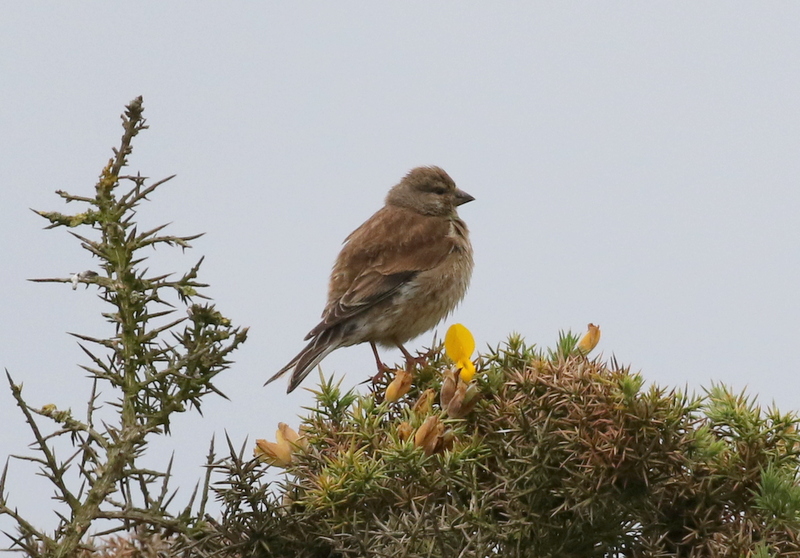 Linnet – we saw lots up on the Heath today
Linnet – we saw lots up on the Heath today
When we got to the first Dartford Warbler territory, it all seemed rather lifeless at first. Still, we had a quiet look round and listen to see if we could hear one call. We walked along a path flanked by high gorse either side and as we came out the other side, we spotted a small, dark shape zipping away over the heather. It was a female Dartford Warbler. It perched in the top of the heather briefly, before dropping down out of sight.
We walked round to where we might see it better and could just see it from time to time flitting around in the heather and young birch trees. Then we heard more Dartford Warblers calling from the other side of the path and realised there was a family party here. Watching quietly from a discrete distance, we could just make out several short-tailed juvenile Dartford Warblers hiding in a big clump of gorse and birch as they moved around.
Standing here for a while, we watched as the female Dartford Warbler flew in to feed the juveniles a couple of times, zooming in fast and low, a dark blur with a long tail, before zooming out again across the path and down into the heather. At least we were seeing Dartford Warblers, but it was hard to get a really good view of one like this. Perseverance was required!
We had heard it singing some distance away but then the male Dartford Warbler flew in to join the female. It didn’t stay long and made its way off in the other direction, so figuring we would stand a better chance of getting a good view of the male perched up singing, we followed it. It did indeed land in the top of the gorse briefly for us, but then flew off over the top of a big clump of young trees and disappeared.
The views we were getting of Dartford Warbler were steadily improving, so we went back to the female and juveniles. Again, they were well tucked down in the vegetation, but after a while the female called the youngsters across the path and we saw at least five of them follow after her – a good clutch, and nice to confirm that this pair have done so well.
Then the male Dartford Warbler reappeared nearby and started singing again, so we followed the sound once more. This time we got a really good look at it, perched in the top of the heather, albeit a reasonable distance away. At last!
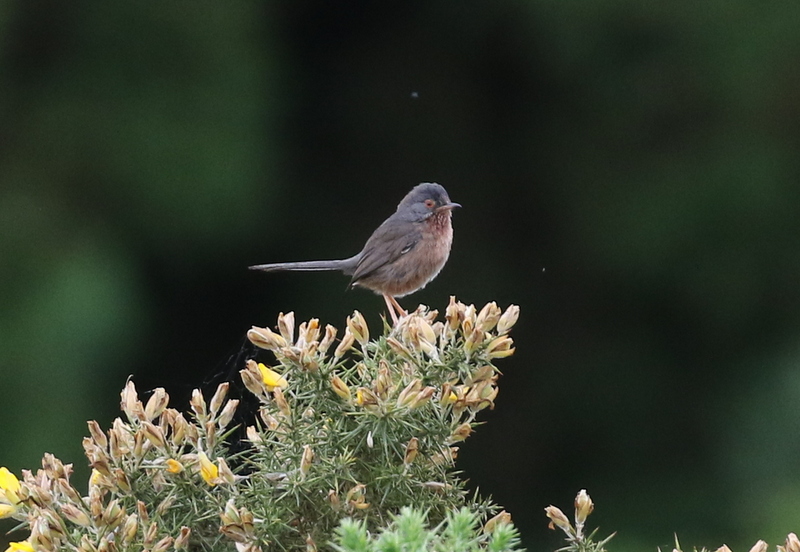 Dartford Warbler – finally, we got a good look at the male perched up singing
Dartford Warbler – finally, we got a good look at the male perched up singing
With some good views of Dartford Warbler achieved, we left the family group to feed and carried on around the Heath. We hadn’t gone very far when we heard another male Dartford Warbler singing, #2 for the morning! This one was tucked well down in a big clump of gorse and birch and we could just see it creeping around in the vegetation. It was never going to be easy to see this one well, so we didn’t stop.
There is an interesting ‘tent’ of Small Eggar moth caterpillars in a bush by one of the paths so we went over for a look at it. We could hear Garden Warblers alarm calling as we approached and one flew across into a young oak tree nearby, where we got a brief view of it before it went further back into the trees. Then a second Garden Warbler appeared in the top of the bush right in front of us, also scolding us. They obviously have a nest nearby, so we left them in peace.
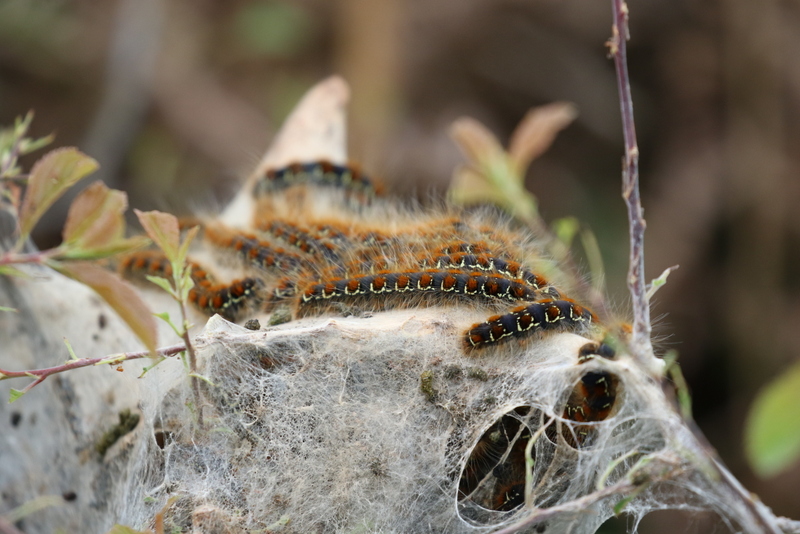 Small Eggar moth caterpillars – in, and on, their silk tent
Small Eggar moth caterpillars – in, and on, their silk tent
As we continued on across the Heath, we heard yet another Dartford Warbler calling and looked round to see another male perched on the top of the heather. It darted back into the gorse behind and disappeared but a few seconds later flew out again. It flew straight towards us, past us within a couple of metres and dropped into a large patch of tall gorse the other side of the path. Dartford Warbler male #3.
We could hear now the mournful song of a Woodlark away in the distance, but as we carried on along the path we gradually got closer to it. It went quiet for a while and then suddenly it fluttered up in front of us and started singing again. We stood and listened to it for a while, watching as it flew round in circles, slowly gaining height. It looked rather bat-like, with rapidly fluttering broad wings and short tail.
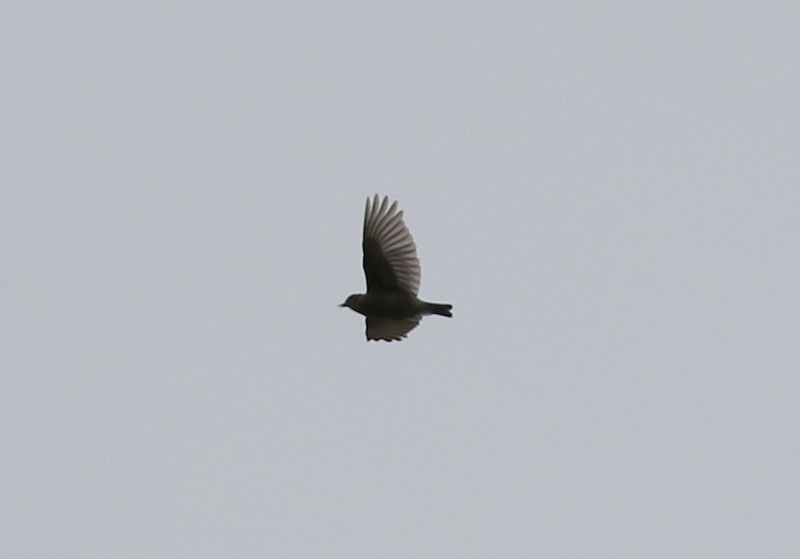 Woodlark – singing high in the sky above our heads
Woodlark – singing high in the sky above our heads
The Woodlark was showing no sign of coming back down to earth, so we carried on our way. It seemed to follow us though and was still singing very high overhead, just a dot in the sky, when we caught a flash of another Woodlark flying over the path in front of us just above head height.
It dropped down into the heather out of sight, so we walked round to a gap in the gorse through which we could see over to the area where it had gone down. The next thing we knew, a pair of Woodlarks flew up out of the heather and disappeared away over the Heath. Perhaps this was why the first male Woodlark was singing so persistently, with another pair in its territory.
A little further on, we had just stopped to admire some more Linnets, when we heard yet another male Dartford Warbler singing, amazingly #4 of the morning! We walked round to the other side of a large gorse bush and there it was, sitting up in full view, albeit quite a distance away.
It was already turning out to be an amazing morning for Dartford Warblers, but there was still one last twist. As we looked at it, male #4 flew straight towards us and landed in the top of a gorse bush right next to us, just a couple of metres away. It was so close, we could almost reach out and touch it! It was a stunning view, and it stayed there for several seconds. It was carrying food in its bill (presumably it has some juveniles to feed somewhere) and gave another burst of song, before flying across the path and away, dropping down again some distance off. Wow!
 Dartford Warbler – this male flew in and landed right next to us!
Dartford Warbler – this male flew in and landed right next to us!
It had been a phenomenal morning for Dartford Warblers, culminating in such great views. We set off to see if we could get better views of a Woodlark now, making out way over to an area where they can sometimes be found feeding, and where the singing male from earlier seemed to have headed off to. A Jay was hopping around under an oak tree by the path and gave us a great look at it when it flew up into the lowest branches.
 Jay – feeding around an oak tree out on the Heath
Jay – feeding around an oak tree out on the Heath
At this point, it started to rain but we could see brighter sky away to the west, so we were confident it was only a shower. So it proved and it quickly stopped again. We paused to watch a family of Stonechats, the adult male, browner female and 2-3 streaky juveniles.
 Stonechat – the female perched up nicely for us during the rain shower
Stonechat – the female perched up nicely for us during the rain shower
Just as we got to the area where we had hoped to find the Woodlark, it started singing again some distance away, back where we had first heard it, so it was immediately obvious we wouldn’t find it here. We turned and made our way back.
A pair of Turtle Doves flew across ahead of us, but disappeared behind the trees before everyone could see them. We headed over in the direction they had seemed to be going in the hope the male might start purring, but there was no sound. The male Yellowhammer we had seen earlier was back in the same tree again, preening and stretching after the rain, as we passed by.
 Yellowhammer – a male in its favourite tree
Yellowhammer – a male in its favourite tree
We had not seen many butterflies today up on the Heath, probably not a surprise given the cloudy and cool weather, but as we made our way back towards the car we were in for one final treat. A blue butterfly fluttered across the path and landed in the cut heather in front of us. A quick look confirmed it was a Silver-studded Blue, a rare and localised species for which the Heath is one of the only sites where it can be found locally.
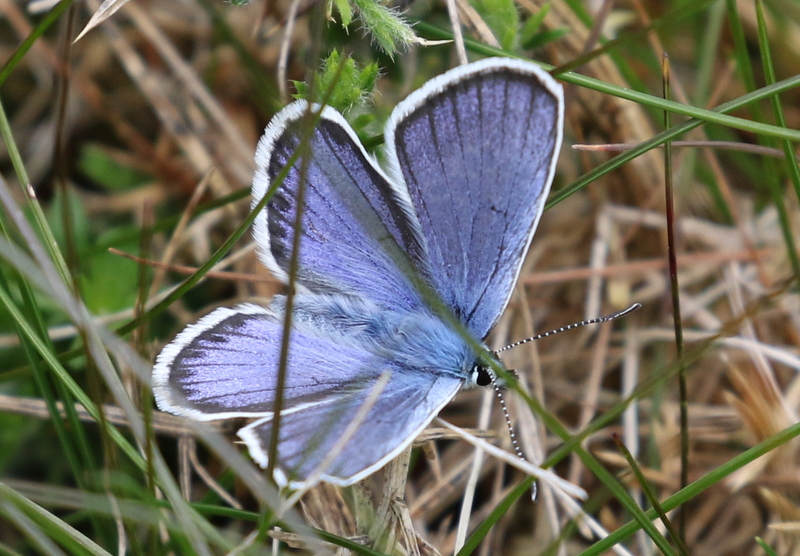 Silver-studded Blue – now starting to emerge on the Heath
Silver-studded Blue – now starting to emerge on the Heath
This is the first Silver-studded Blue we have seen this year and, following reports from Suffolk in the last couple of days, they have probably only just started to emerge here. It was quite sluggish in the cooler weather and we got a great look at it, noting the distinctive silvery-blue centred spots on the underside of the hindwing from which it gets its name. As we walked on along the path, we found a second Silver-studded Blue in the heather.
With the rain forecast to arrive in the afternoon, and having spent most of the morning on the Heath, we had hoped to have a quick walk down on the coast before lunch. However, as we drove down we could see dark clouds ahead of us and the next thing we knew it was raining hard.
We headed round to the visitor centre at Cley and went inside for a cup of tea, in the hope that it might be just another shower, but it quickly became clear the main band of rain had arrived early. We could see plenty of Shelducks and Avocets on Pat’s Pool from the centre, but with most of the group not having a full set of waterproofs with them (not something you generally pack for summer!), we were not going to be able to get out to the hides without getting soaked.
After an early lunch in the car, with Common Swifts and Sand Martins hawking for insects in the rain low over the car park, we drove round to the beach. The wind had picked up now and it was really blustery, with gusts up to around 40mph already. We nipped across from the car to the beach shelter, where we could get out of the wind and rain, and had a look at the sea. There were lots of Sandwich Terns feeding close in offshore and we picked out several Little Terns and a couple of Common Terns too.
 Sandwich Tern – feeding just offshore in the wind & rain
Sandwich Tern – feeding just offshore in the wind & rain
Our only hope now was that the rain, having arrived earlier than forecast, would go through more quickly too. We had hoped to spend the afternoon at Holkham, so we started to drive slowly west, stopping on the way at several sites where we could look out from the car. The harbours at Blakeney and Morston were largely devoid of birds. At Stiffkey Greenway, the only large white shape we could see was a Little Egret but visibility was somewhat hampered by the rain. There was more to see at Wells Harbour, with a couple of Common Terns and a Little Tern flying round or perched on one of the sandbars.
At this point, the group decided it might be an idea to call it a day. Finally managing to pick up a decent 4G mobile signal in Wells, we checked the rainfall radar in the hope it might show that the rain was passing through quickly, but the opposite appeared to be the case, so we made our way back to where we started. It was a disappointing way to end, but at least we had made the most of the good weather this morning. Those views of Dartford Warbler will live long in the memory!
















